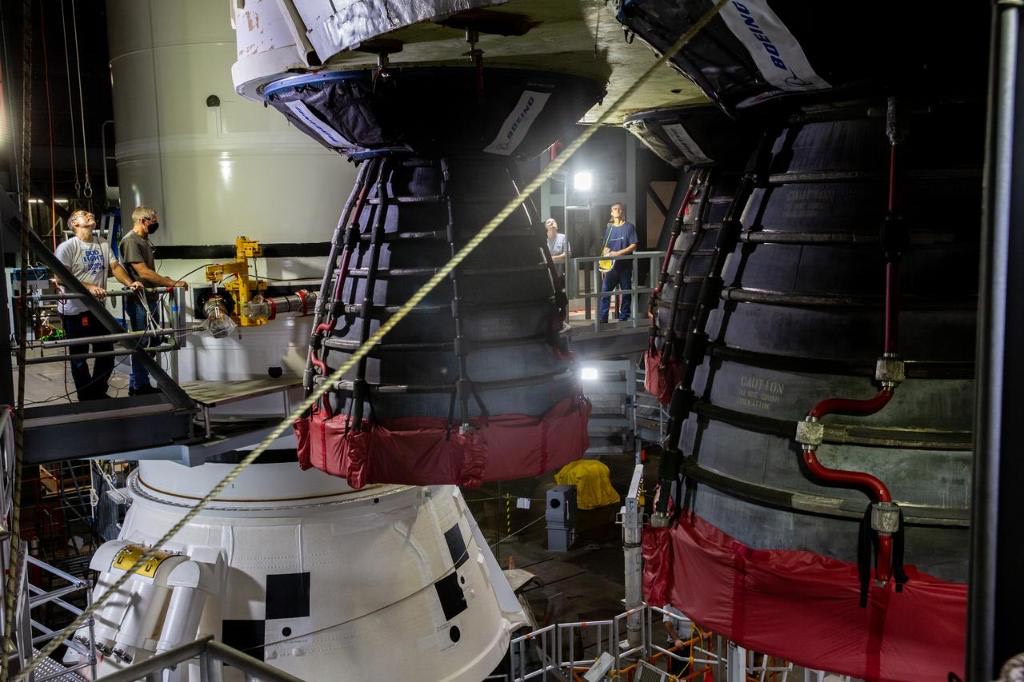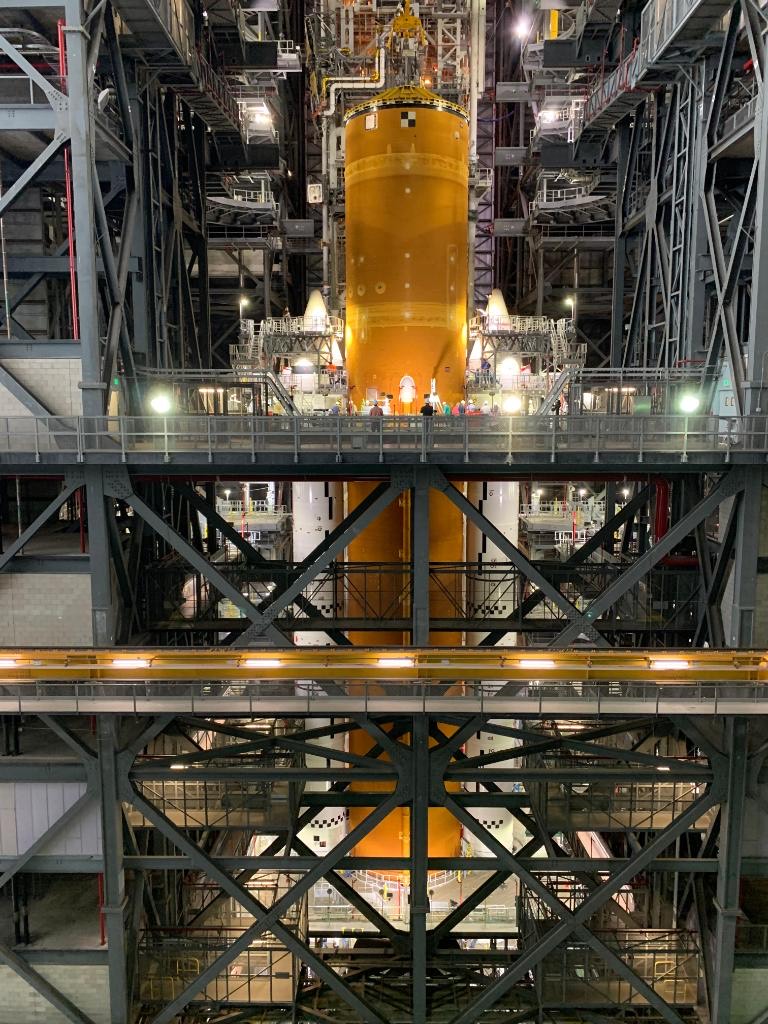NASA's new moon rocket, the Space Launch System, takes shape in giant hangar
The SLS moon rocket for Artemis 1 is all stacked up.
CAPE CANAVERAL, Fla. — NASA is one step closer to the moon. The space agency's next megarocket, the Space Launch System (SLS) is coming together ahead of its first planned launch later this year.
The behemoth's core stage arrived at NASA's Kennedy Space Center, via barge on April 27, before rolling into the massive Vehicle Assembly Building (VAB), its home until launch.
The agency celebrated the milestone, which marked the first time that all of the rocket's components were in the same place and the first time a rocket bound for deep space was in the VAB since the end of the Apollo era.

After its arrival, the core stage spent the next few weeks in the transfer aisle of the VAB before it was hoisted on top of the mobile launch platform to join the two solid rocket boosters that are already stacked in High Bay 3.
"This is the first time that the complete flight unit has come together," Sean Arrieta of NASA's Exploration Ground Systems told Space.com in a recent interview. "We're all really excited."
This summer, the agency's new Orion spacecraft will be mated with the SLS and prepared to blast off on an uncrewed test flight around the moon later this year as part of the Artemis 1 mission. If all goes as planned, agency officials said that the flight could take place as early as November.

The core stage is the backbone of the rocket, which stands 212 feet (65 meters) tall. Workers used a 325-ton crane to hoist the core stage into the air, transferring it to a nearby high bay. From there, it was stacked on top of its mobile launch platform, and in between two 177-foot-tall (54 m) solid rocket boosters.
Get the Space.com Newsletter
Breaking space news, the latest updates on rocket launches, skywatching events and more!
Built by Northrop Grumman, the boosters are longer versions of the solid rocket motors that once powered the agency's fleet of space shuttles. In fact, each of the five segments flew on multiple space shuttle missions before being refurbished for the SLS program.
The successful stacking of the core stage is just the start of a process to fully assemble the rocket ahead of launch. If all goes as planned, we could see a complete launch system, with Orion spacecraft perched on top, by August.
NASA would be on track to move the 322-foot-tall (98-meter) rocket to pad 39B for preflight testing in September or October. At that time, the crews would run through launch countdown procedures and mock fueling.
Related: NASA fires up 1st SLS megarocket for moon flights in a critical engine test

Four RS-25 engines — the same engine that powered the space shuttle — will power SLS, along with an added boost from the twin solid rocket boosters, generating more than 8 million pounds of thrust. NASA puts the engines, which were built by Aerojet Rocketdyne, through their paces earlier this year as part of a series of green run tests.
The testing culminated with a hot fire test at NASA's Stennis Space Center in Mississippi, on March 18, a repeat of an identical test that ended prematurely back in January. Simulating a real launch, the engines were fired up and burned for more than eight minutes while firmly affixed to a test stand.

That was the last major hurdle the craft had to clear ahead of the main event: launch day. NASA is hoping to launch the SLS and Orion crew capsule on an unpiloted test flight around the moon as soon as late November.
The mission, known as Artemis 1, will last more than three weeks and pave the way for Artemis 2, which will carry a four-person crew around the moon in 2023.
Beyond that, the agency plans to start landing astronauts near the lunar south pole with the help of commercially developed lunar landers. In April, NASA selected the first of those landers — a version of SpaceX's Starship — to land the first Artemis crew on the moon.
In Photos: NASA's Kennedy Space Center renovates Launch Pad 39B for Orion
The rest of the assembly should go fairly quickly, according to NASA, with a November launch on the horizon. The agency says the next steps are to install the launch vehicle stage adaptor (LVSA), followed by the upper stage, known as the Interim Cryogenic Propulsion Stage (ICPS), which is a hydrogen-fueled upper stage.
After that, the crews will install a structure to simulate the weight of Orion so that more testing can be done before the actual Orion is installed at the end of the summer.
"We're excited to finally have all the hardware here in Florida," Arietta told Space.com after the core stage's arrival. "We've had some challenges along the way, but we are confident we can launch this year."
Follow Amy Thompson on Twitter @astrogingersnap. Follow us on Twitter @Spacedotcom or Facebook.
Join our Space Forums to keep talking space on the latest missions, night sky and more! And if you have a news tip, correction or comment, let us know at: community@space.com.

Amy Thompson is a Florida-based space and science journalist, who joined Space.com as a contributing writer in 2015. She's passionate about all things space and is a huge science and science-fiction geek. Star Wars is her favorite fandom, with that sassy little droid, R2D2 being her favorite. She studied science at the University of Florida, earning a degree in microbiology. Her work has also been published in Newsweek, VICE, Smithsonian, and many more. Now she chases rockets, writing about launches, commercial space, space station science, and everything in between.









